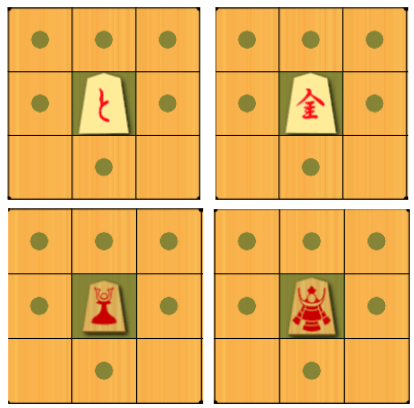Mini Shogi
Mini Shogi (Japanese Chess on a smaller board)
Rules
The rules of Mini Shogi are almost the same as Shogi, but with fewer pieces and played on a 5 x 5 board. The game was invented (or rediscovered) around 1970 by Shigenobu Kusumoto of Osaka, Japan. Players take it in turns moving pieces on the board to checkmate the enemy king. Captured pieces can be placed back onto the board (like the crazyhouse variant in chess) with some restrictions notably pawns, which will be explained in a later section. Almost all pieces can be promoted into a stronger version of themselves upon entering (or moving from) their last rank and are ‘flipped over’ to show the promoted side. As in crazyhouse when a piece is captured the un-promoted side is added to the players pool or pieces to drop onto the board.
Pieces
The two sets of pieces are called Sente (Black) and Gote (White). Sente is the first player. With the western piece-set (shown in the right of all example diagrams) the coloured line under the king piece indicates which side the piece is on. All pieces capture, and check the opponents king, with their standard movement. To capture an opponent’s piece you must land on it exactly.
King (K)
The King moves exactly like in chess, one step in any direction. For the general pieces set, to distinguish the kings, the black king has a dot, whereas the white king does not.
Rook (R)/Dragon King (+R or D)

The rook moves exactly like a chess rook, any squares left/right or up/down.
The promoted rook (Dragon) can also move 1 square in any direction.
Bishop(B)/Dragon horse (+B or H)

The bishop moves exactly like a chess bishop, any number of squares diagonally.
The promoted bishop (Horse) can also move 1 square in any direction.
Golden general (G)
The golden general cannot be promoted, it can move one square in any direction except backwards diagonally.
Silver general (S)
The silver general can move 1 step diagonally in any direction or 1 step forward.
Pawn (P)
A pawn moves and captures by moving one square forward. This is different to chess where a pawn captures diagonally forward.
Minor pieces (promote to have golden general movement)

A promoted minor piece respectively (+P, +S) can also move like a gold general.
Additional Rules
Drops
Captured pieces can be dropped anywhere on the board even to provide checkmate instead of moving a piece already on the board. The main exception of drops concerns pawns:
- Pawns cannot be dropped onto the same file as another un-promoted pawn
- Pawns cannot be dropped to give checkmate, checks are okay
- No piece can be dropped if it has no legal moves (usually the last rank for a pawn)
- A dropped piece is not promoted straight away, even if dropped on the last rank.
Stalemate
If a player cannot make a legal move, the game ends in Stalemate. Unlike Chess, Stalemate is a loss for the player who cannot move.
Perpetual check
The player repeating check causing a position to repeat 4 times in a row is a loss, in chess this is a draw.
Repetition
Repetition, repeating the same position 4 times in a row (including pieces in hand) is a draw.
Notation
There are several notations used for Shogi, we currently use the western notation on this site. The board is indexed by two numbers e.g. (1,1) but starting from the top right corner from white’s point of view (as black typically goes first), therefore a4 becomes 52.
- The piece symbol is given first
- Drops are indicated with “*”, captures with “x”, and general move as “-“, e.g. P*52, Px52, P-52
- Moves that end in a promotion add “+” to the end, if a player chooses not to promote “=” is added instead




